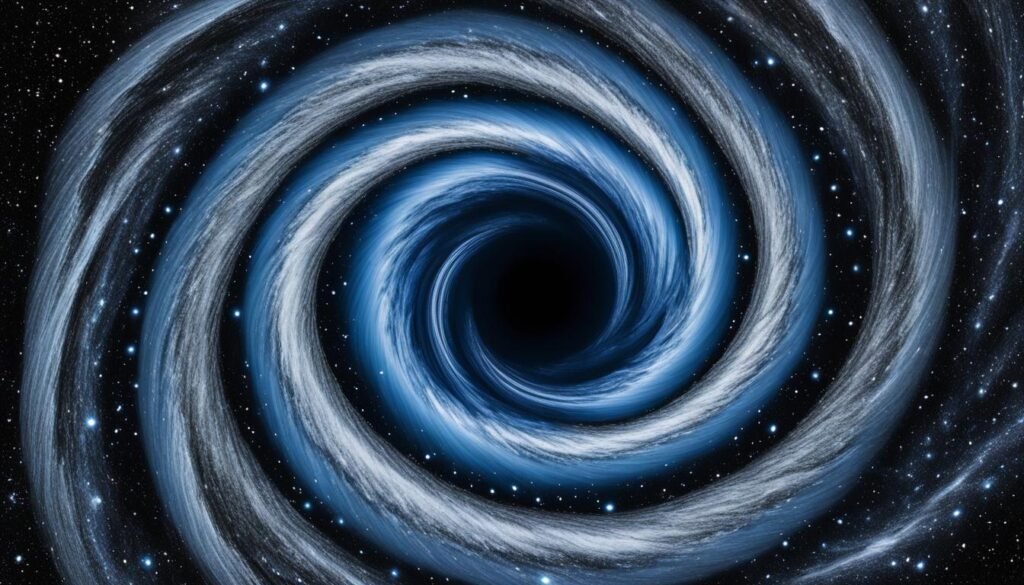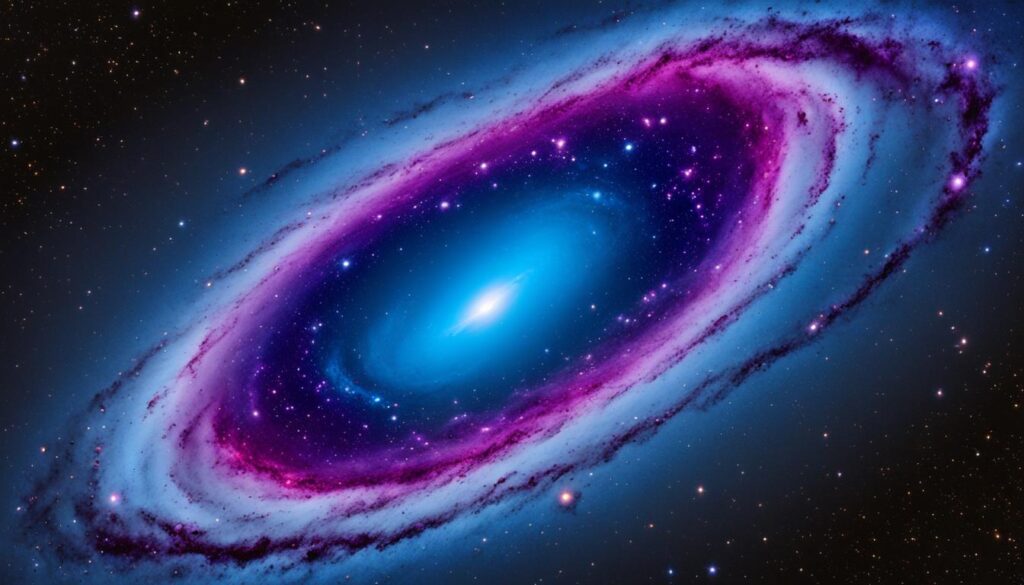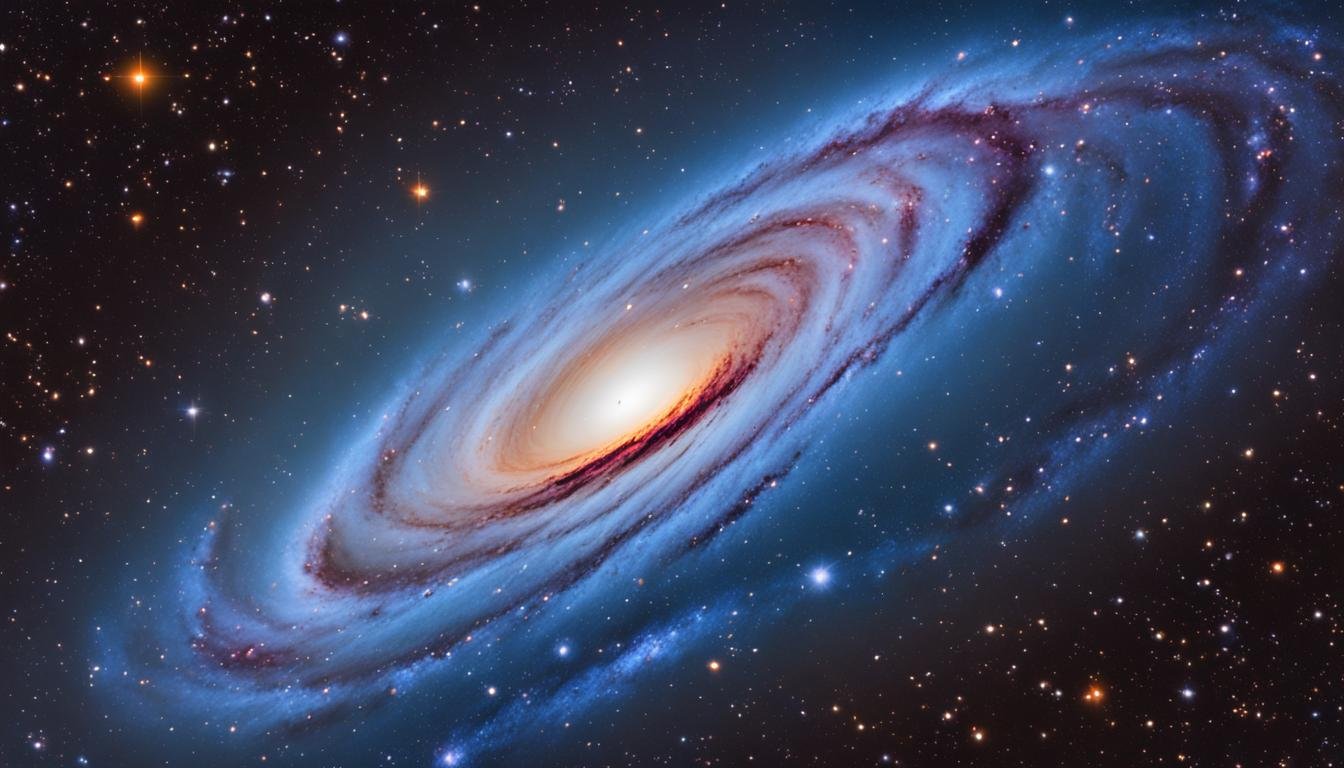Welcome to a fascinating journey through the vastness of space. In this article, we will explore the enigmatic beauty of Messier 64, also known as the Black Eye Galaxy. Get ready to encounter a celestial wonder that will leave you in awe, as we uncover the remarkable features and captivating history of this distant spiral galaxy.
Key Takeaways:
- Messier 64, or the Black Eye Galaxy, is a spiral galaxy located in the Coma Berenices constellation.
- Its nickname comes from the dark band of absorbing dust that partially covers its bright nucleus, resembling a black eye.
- Messier 64 exhibits unique internal motions, with counter-rotating gas in its outer regions resulting from a satellite galaxy absorption.
- The collision and merging of galaxies triggered active star formation in Messier 64, leading to the presence of young, hot stars and glowing hydrogen gas.
- By studying Messier 64, scientists gain insights into galaxy formation and evolution, deepening our understanding of the universe.
Features of Messier 64
Messier 64, also known as the Black Eye Galaxy, exhibits several distinctive features that make it a captivating subject for study. With its intriguing morphology and unique characteristics, Messier 64 offers valuable insights into the nature of galaxies and their evolution.
Diameter and Classification
Messier 64 has a diameter of 16.51 kiloparsecs, equivalent to approximately 53,800 light-years. This size places it among the larger galaxies in the known universe. In terms of its classification, Messier 64 falls into the (R)SA(rs)ab category. Its outer structure forms a prominent ring-like feature, while its tightly wound spiral arms add to its visual appeal and complexity.
Inclination and Position Angle
The inclination of Messier 64 is measured at 60 degrees, indicating its tilt with respect to our line of sight. Additionally, the position angle of the galaxy is determined as 112 degrees, denoting the orientation of its major axis. These parameters contribute to the unique appearance and perspective of the Black Eye Galaxy.
Radio Emission and Nucleus
Messier 64 exhibits a weak source of radio emission in its central region. This emission hints at the presence of various cosmic phenomena, such as active star formation and interactions between interstellar gases. Additionally, the galaxy showcases an HII/LINER (ionized hydrogen/low-ionization nuclear emission-line region) nucleus, signifying the presence of regions with intense star formation and the activity generated by its central supermassive black hole.
The table below summarizes the key features of Messier 64, showcasing its distinct attributes in a concise and informative manner:
| Feature | Description |
|---|---|
| Size | 16.51 kiloparsecs in diameter (approximately 53,800 light-years) |
| Classification | (R)SA(rs)ab, with a ring-like outer structure and tightly wound spiral arms |
| Inclination | 60 degrees |
| Position Angle | 112 degrees |
| Radio Emission | Weak source in the central region |
| Nucleus | HII/LINER nucleus, indicative of active star formation and black hole activity |
These features of Messier 64 contribute to its allure and scientific significance, offering astronomers and researchers intriguing avenues for exploration and understanding in the realm of galaxies.
Unusual Internal Motions in M64
One of the most fascinating aspects of Messier 64 is its unusual internal motions. Studies in the 1990s revealed that the interstellar gas in the outer regions of the galaxy rotates in the opposite direction from the gas and stars in the inner regions. This counter-rotating gas is believed to have resulted from the absorption of a satellite galaxy by M64, possibly more than a billion years ago. The collision and subsequent merging of the two galaxies created the unique internal dynamics observed in M64.

Counter-Rotating Gas in Messier 64
The counter-rotating gas in Messier 64 is an intriguing phenomenon that challenges our understanding of galactic dynamics. It suggests a complex history of mergers and interactions that have shaped the galaxy over billions of years.
Further studies and observations are needed to fully comprehend the implications of these unusual internal motions and their impact on the overall structure and evolution of Messier 64.
| Internal Motions | Observations | Implications |
|---|---|---|
| Counter-rotating gas in outer regions | Opposite direction of rotation compared to inner regions | Resulted from absorption of a satellite galaxy |
| Merging of two galaxies | Creation of unique internal dynamics | Contributes to the formation and evolution of Messier 64 |
Active Star Formation in M64
The counter-rotating gas and dust clouds in Messier 64 have sparked a flurry of star formation within the galaxy. The collision between these two galaxies compressed and contracted the gases, providing the perfect conditions for the birth of new stars. In the region where the oppositely rotating gases collide, star formation rates are particularly high, resulting in the emergence of hot, young blue stars and vibrant pink clouds of glowing hydrogen gas.
This active star formation within Messier 64 is a direct consequence of the interaction between the gas clouds and the ultraviolet light emitted by the recently formed stars. These intense processes contribute to the ongoing evolution of the galaxy and shape its unique characteristics.
Prominent Features
The active star formation within Messier 64 gives rise to several prominent features that are visually captivating:
- Hot, Young Blue Stars: The intense star formation generates a population of bright, young blue stars in the galaxy. These stars are massive and emit a tremendous amount of energy, illuminating the surrounding space with their intense blue light.
- Pink Clouds of Glowing Hydrogen Gas: The emergence of new stars is often accompanied by the presence of glowing hydrogen gas clouds. These clouds are rich in ionized hydrogen, which emits pink light when excited by the energetic radiation from nearby stars.
These features make Messier 64 a fascinating object of study, as they provide valuable insights into the ongoing processes of star formation and galaxy evolution.
Star Formation in Messier 64
| Characteristics | Description |
|---|---|
| Active Star Formation | Intense star formation within the galaxy due to the collision of two galaxies and subsequent compression and contraction of gases. |
| Hot, Young Blue Stars | Energetic and massive stars formed as a result of the intense star formation process. |
| Pink Clouds of Glowing Hydrogen Gas | Ionized hydrogen gas clouds that emit pink light as a byproduct of star formation. |
Formation History of Messier 64
The formation history of Messier 64, also known as the Black Eye Galaxy, is a fascinating story that dates back over a billion years. This captivating spiral galaxy underwent a significant event in its past – a collision with a satellite galaxy. This collision played a crucial role in shaping the unique characteristics and structures observed in Messier 64 today.
The absorption of the satellite galaxy by Messier 64 resulted in the formation of counter-rotating gas within the galaxy. This phenomenon occurs when the gas in the outer regions of the galaxy rotates in the opposite direction from the gas and stars in the inner regions. The collision and subsequent merging of the two galaxies led to the creation of this intriguing internal dynamic.
Although the satellite galaxy has been mostly destroyed, evidence of the collision can still be seen in the backward motion of the gas at the outer edge of Messier 64. These remnants of the merger serve as a reminder of the complex interactions that shape the formation and evolution of galaxies.
Studying the formation history of Messier 64 provides valuable insights into the intricate processes involved in galaxy mergers. By unraveling the secrets of how galaxies like Messier 64 form, scientists can gain a better understanding of the larger universe and the evolution of galaxies like our own Milky Way.
The unique formation history of Messier 64 has been a subject of extensive research and observation. Astronomers have used various telescopes, including the Hubble Space Telescope, to study the fine details of this galactic collision and its aftermath. These observations not only deepen our understanding of Messier 64 but also contribute to our knowledge of galaxy formation on a larger scale.

Observation and Exploration of Messier 64
Messier 64, also known as the Black Eye Galaxy, is a captivating celestial object that has attracted the attention of both amateur and professional astronomers. Its distinct appearance in small telescopes makes it a popular target for observation, while space telescopes like the Hubble Space Telescope have provided valuable insights into its structure and dynamics.
Amateur astronomers often marvel at Messier 64’s dark band of absorbing dust, which gives the galaxy its unique and visually appealing appearance. The contrast between the dark band and the bright nucleus adds to its allure, making it a fascinating subject to explore through telescopes.
Professional astronomers have taken advantage of advanced technologies to study Messier 64 in more detail. Space telescopes like the Hubble Space Telescope have provided high-resolution images that reveal fine structures and intricate details of the galaxy’s spiral arms. These observations have allowed scientists to gain a deeper understanding of the processes involved in galaxy evolution.
By studying Messier 64, astronomers can uncover valuable insights into the formation and development of galaxies. The exploration of this enigmatic cosmic object contributes to our broader understanding of the universe and sheds light on the intricate mechanisms that shape galaxies over billions of years.
Engaging in the observation and exploration of Messier 64 not only allows us to appreciate the beauty of the cosmos but also fuels our curiosity about the vast expanse beyond our planet. As we continue to delve deeper into the mysteries of the universe, the study of galaxies like Messier 64 brings us closer to unraveling the secrets of our cosmic origins.
Location and Distance of Messier 64
Messier 64, also known as the Black Eye Galaxy, is situated in the northern constellation of Coma Berenices. Located at approximately 12h 56m 43.7s in right ascension and +21° 40′ 58″ in declination, it can be observed from various parts of the world.
However, capturing its true beauty requires the use of a telescope, as its distance from Earth is approximately 17 million light-years. This distant location in the universe makes Messier 64 a fascinating celestial object to study and explore.
By examining the properties and characteristics of this galaxy, astronomers gain valuable insights into the nature of distant galaxies and the processes involved in their formation and evolution.
Other Names and Designations for Messier 64
In addition to its popular name, the Black Eye Galaxy, Messier 64 is known by various other names and designations. It is designated as NGC 4826 in the New General Catalogue and PGC 44182 in the Principal Galaxy Catalogue.
Other names include Evil Eye Galaxy and Sleeping Beauty Galaxy.
These different names highlight the diverse perspectives and interpretations of this captivating cosmic object.
Messier 64 Other Names and Designations
| Name | Designation |
|---|---|
| Black Eye Galaxy | Popular Name |
| Evil Eye Galaxy | Alternative Name |
| Sleeping Beauty Galaxy | Alternative Name |
| NGC 4826 | New General Catalogue Designation |
| PGC 44182 | Principal Galaxy Catalogue Designation |
Importance of Studying Messier 64
The study of Messier 64, also known as the Black Eye Galaxy, is of utmost importance in advancing our understanding of galaxy formation and evolution. This unique cosmic object offers valuable insights into the intricate processes that shape galaxies, making it an essential subject of research.
One of the significant aspects of Messier 64 is its counter-rotating gas, a feature not commonly observed in other galaxies. This phenomenon provides scientists with a rare opportunity to study the dynamics of galactic systems and unravel the mysteries behind their formation. By investigating this peculiar characteristic, researchers can gain a deeper understanding of how galaxies like our own Milky Way have evolved over billions of years.
Another crucial aspect of Messier 64 is its active star formation. The collision between the absorbing dust clouds in the galaxy triggered the formation of new stars, resulting in a region of intense stellar birth. Studying this process can help scientists comprehend the mechanisms behind star formation in different galactic environments and shed light on the fundamental processes that drive the evolution of galaxies.
By examining the unique features and characteristics of Messier 64, scientists can broaden their knowledge of galaxy formation and gain insights into the broader context of the universe. The study of Messier 64 is like peering into the inner workings of the cosmos and uncovering the intricate dance of celestial bodies, leading to a deeper understanding of the universe we inhabit.
FAQ
What is Messier 64 Black Eye Galaxy?
Messier 64 Black Eye Galaxy, also known as the Evil Eye Galaxy, is a spiral galaxy located approximately 17 million light-years away in the Coma Berenices constellation. It gets its name from the dark band of absorbing dust that partially covers its bright nucleus, giving it the appearance of a black eye.
What are the features of Messier 64?
Messier 64 has a diameter of approximately 53,800 light-years and belongs to the (R)SA(rs)ab morphological classification. It is inclined at an angle of 60 degrees and has tightly wound spiral arms and an outer ring-like structure. The central region of M64 is a weak source of radio emission, and it exhibits an HII/LINER nucleus.
What are the unusual internal motions in Messier 64?
Studies have shown that the interstellar gas in the outer regions of Messier 64 rotates in the opposite direction from the gas and stars in the inner regions. This counter-rotating gas is believed to have resulted from the absorption of a satellite galaxy by M64, possibly more than a billion years ago.
How does active star formation occur in Messier 64?
The collision between two galaxies, including Messier 64 and a satellite galaxy, compressed and contracted the gases, triggering the formation of new stars. The region where the oppositely rotating gases collide exhibits a high rate of star formation, with hot, young blue stars and pink clouds of glowing hydrogen gas being prominent features in the galaxy.
What is the formation history of Messier 64?
Messier 64 absorbed a satellite galaxy over a billion years ago, resulting in counter-rotating gas and the unique structures observed in the galaxy today. Remnants of the collision can still be seen in the backward motion of the gas at the outer edge of M64.
How has Messier 64 been observed and explored?
Messier 64 has been extensively studied by professional astronomers using space telescopes such as the Hubble Space Telescope. These observations have revealed fine details of its structure and internal dynamics, contributing to our understanding of galaxy evolution.
Where is Messier 64 located and how far is it from Earth?
Messier 64 is located in the Coma Berenices constellation with coordinates 12h 56m 43.7s in right ascension and +21° 40′ 58″ in declination. It is approximately 17 million light-years away from Earth.
What are the other names and designations of Messier 64?
Messier 64 is also designated as NGC 4826 in the New General Catalogue and PGC 44182 in the Principal Galaxy Catalogue. It is known by other names such as Evil Eye Galaxy and Sleeping Beauty Galaxy.
Why is studying Messier 64 important?
The study of Messier 64 provides valuable insights into galaxy formation and evolution. Its unique features, such as counter-rotating gas and active star formation, help scientists understand the complex processes that shape galaxies and the universe as a whole.







